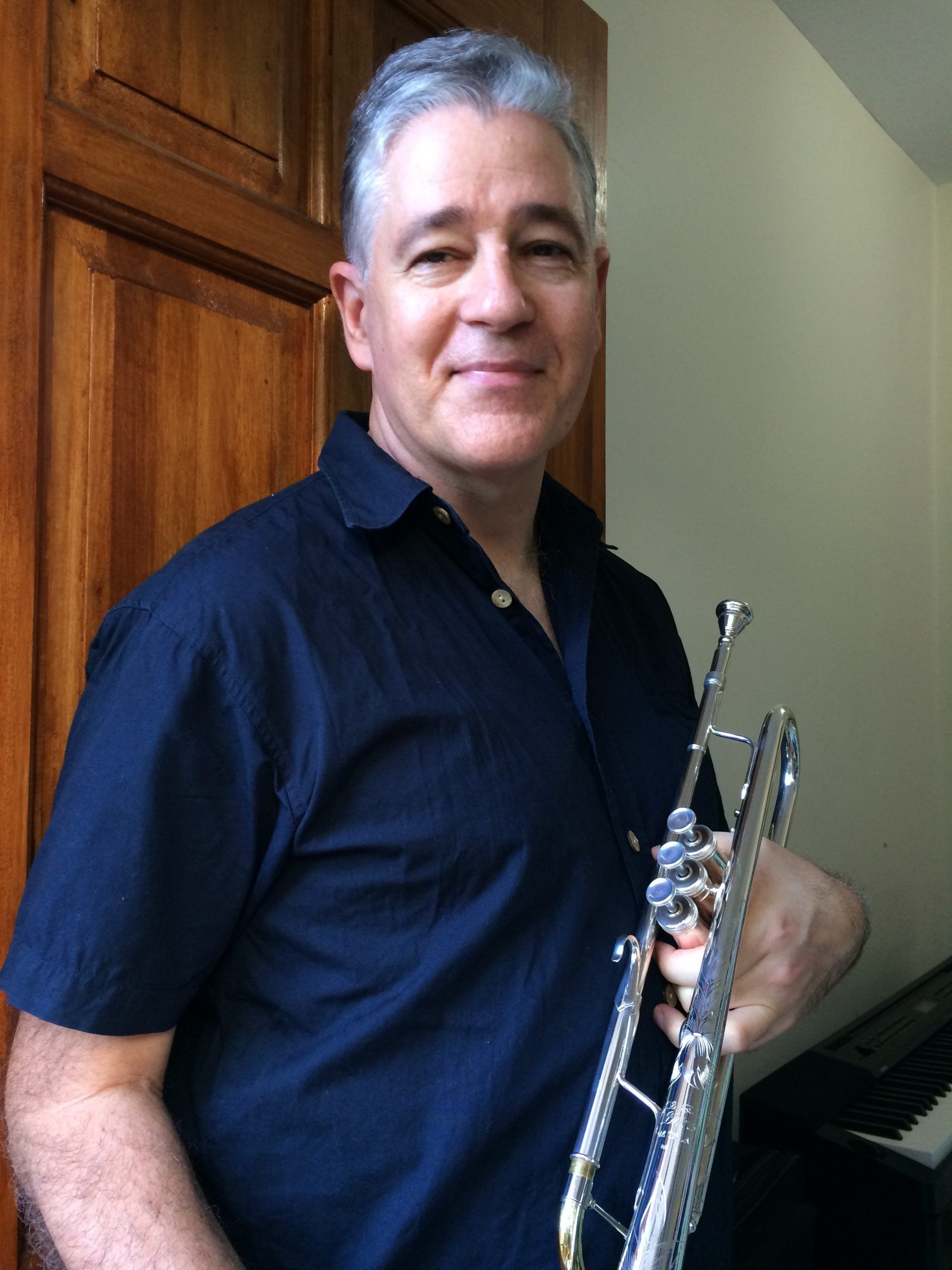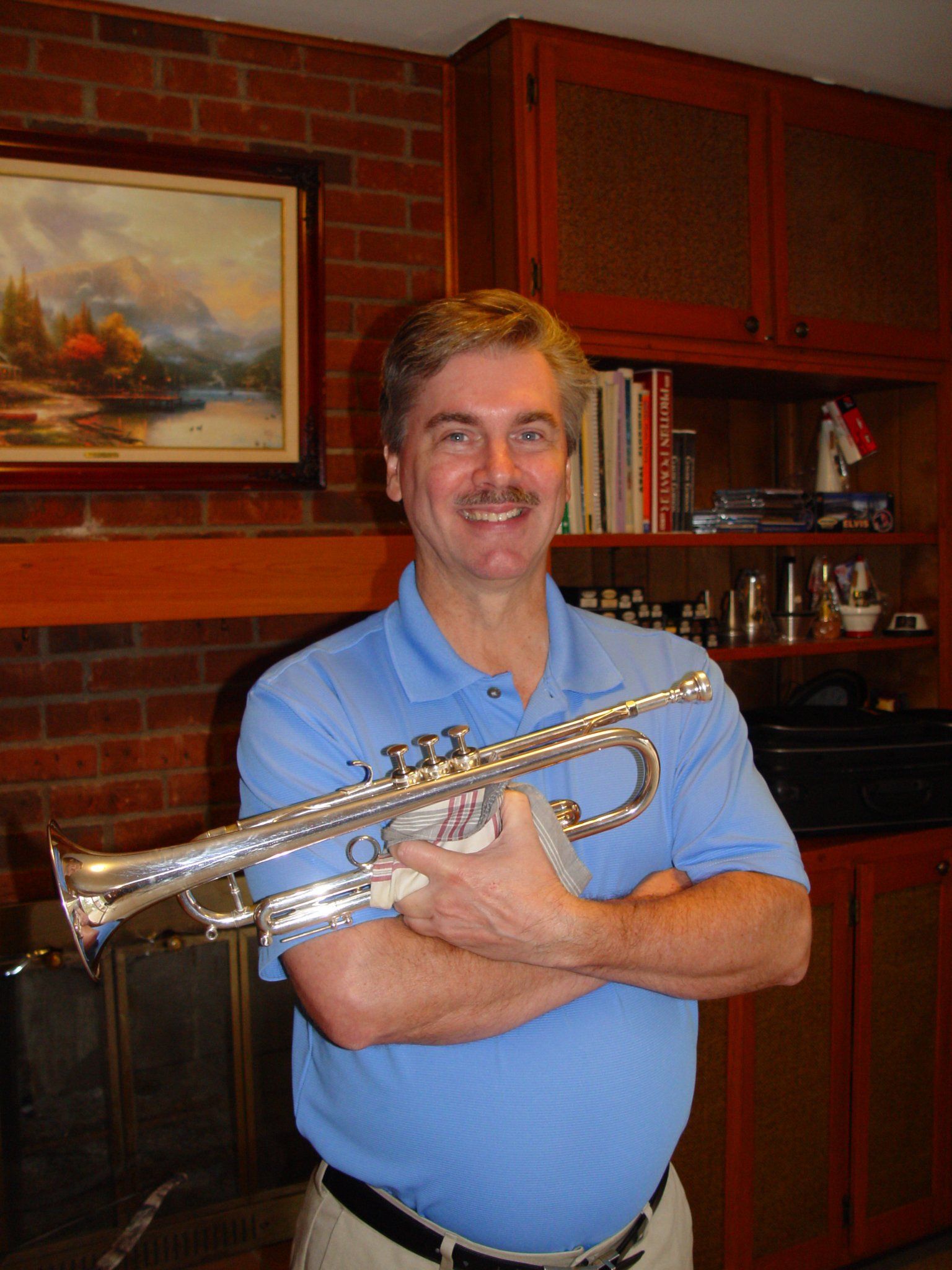Lessons with Claude Gordon and Raphael Méndez
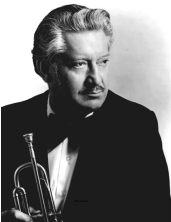
My association with Claude Gordon, “The King of Brass”, began in 1971 during my junior year at West Covina High School in southern California. One day after band, a former band member stopped by for a visit. He had been studying trumpet with Claude Gordon and had been performing regularly at Disneyland in one of the groups. He handed me a slip of paper with a name and phone number on it and said I should get lessons with this man. He said that Claude Gordon was one of the top studio musicians in Los Angeles and a great teacher too. Claude had been first trumpet at CBS for 12 years and a studio musician for 35 years. He was known for his brilliant tone, great facility, and extraordinary accuracy. I took my friend’s advice and called Mr. Gordon. From that fortuitous moment my career as a player and teacher really began.
One year later I landed the solo trumpet chair in the top California All-State High School Honor Band, whereas in the previous year I had only achieved the 3rd trumpet section of the lower band. My progress was astounding to me but Mr. Gordon indicated that we were just getting started. He said that his goal was to get me to where I could play anything that was set before me. Claude Gordon’s approach to brass playing was built upon the foundation given to him through his 10 years of study with the famed Herbert L. Clarke and to some extent upon the teachings of Louis Maggio. It was Herbert Clarke, the most acclaimed of the cornet virtuosos, who was really the first to explain in print how a brass instrument works and set forth the natural physical elements used in brass playing. Claude Gordon distilled these teachings into clear, concise explanations, and mastered the ability to prescribe the proper exercises to bring the desired results.
The many books he authored filled critical gaps in the existing brass methodology, especially pedal and high register studies. His books were not meant to replace any of the great method books already in existence but rather to augment them. Carl Fischer publishes all his books: Systematic Approach to Daily Practice, Daily Trumpet Routines, Physical Approach to Elementary Brass Playing, 30 Velocity Studies, Tongue Level Studies, Brass Playing Is No Harder Than Deep Breathing. Claude also used all the standard methods in his teaching such as Herbert Clarke’s Technical Studies, setting up Drills, Characteristic Studies, Arban’s Method and Saint Jacome’s Grand Method, also Gatti, Irons, Smiths, Staiger, Hering, Schlossberg, the Charles Colin books, and the Ernest Williams Modern Method. Once the student had acquired the necessary facility, he would then work with the various French etude books and general solo literature. He was rightly critical of those teachers who would assign difficult literature to a student before the student was ready to handle it.
A key element to Claude’s teaching success was that he did not bog the student down with too much theory. He gave only enough theory to gain a clear understanding of the matter at hand, citing the old adage, “Too much analyzation causes paralyzation.” After a student’s basics were set correctly, the exercises themselves would bring the needed development and correct most remaining problems. Mr. Gordon stressed systematic development through correct practice rather than the use of gimmicks, gadgets, special embouchures, mouthpieces, and the like which appeal to the gullible player looking for a quick fix to his problems. Trumpet players in search of high notes are especially prone to fall prey to the salesman or teacher who promises overnight results from the purchase of their book or product. “Brass playing is a form of athletics” Claude would often say. “You must train like any athlete to develop the necessary strength and coordination.” He taught that the real secret of success is in knowing “How To Practice, What To Practice, and When To Practice”.
My studies with Claude focused on the development of the seven physical elements of brass playing. (See Setting Up Drills, Herbert L. Clarke, p3) They are Wind Power, Wind Control, The Tongue, The Lips, The Muscles of the Lips and Face, The Fingers of the Right Hand and The Left Hand. (For a more thorough discussion of these items see: Brass Playing Is No Harder Than Deep Breathing, Claude Gordon, pub. Carl Fischer). Breathing exercises were also a very important part of his instruction. I have found the practice of them to be essential in my own playing and in that of my students. Dr. Larry Miller, a noted physician and surgeon, and also a fine trumpet player, has done a series of studies with top players that medically verify the veracity of Claude Gordon’s teaching concerning wind power and its development. (See “Brass Playing Is No Harder Than Deep Breathing”. p16, 17)

My association with Raphael Méndez, “The Heifetz of Trumpet” began a few years before I met Mr. Gordon. Méndez was incredibly inspirational. Few have equaled his technical prowess and stature in the trumpet world. His love of music was infectious, and he loved to spend time helping young players find excellence in their playing. Méndez accompanied a select group of college and high school musicians on a 6-week concert tour of Western Europe in the summer of 1969. He was our featured soloist and trumpet instructor as well. At each performance I was privileged to participate in a trumpet trio with him. Méndez’s private teaching style was less structured than Claude Gordon’s. The lessons were more informal and flexible. We worked a good deal from the Arban Method and with various solos. He even visited my high school band rehearsal one time to help me on a solo I was working on with the band. While he was there, he quickly taught the low brass the background chords and rhythm to the “Carnival of Venice”, borrowed a trumpet from someone, played the melody, and then performed the whole fourth variation with only one finger! His biggest influence upon me came as I observed his devotion and love of music and the trumpet. He exhibited great passion in his playing and generated excitement in me every time I heard him play.
After my family moved from Southern California to the San Francisco Bay Area, I continued seeing Mr. Gordon, though only once a month. I would get up at 2:00 AM on a Thursday morning, drive the 350 plus mile trip to his studio in Woodland Hills and take a 9:00 AM Friday lesson. Since I was his last student for the week, after the lesson we would have breakfast together at a local restaurant. Then I would begin the long drive home while Claude, an avid pilot, hopped into his Cessna 172 and flew back to his mountain home in Big Bear Lake for the weekend with his wife Jenny. I never regretted a mile driven or a dollar spent to study with this great man. In all I knew Claude for 25 years and studied with him over 15 of those years, continually growing and improving as a player. His teaching resources seemed limitless. I found him to be a very personable, humorous, and engaging individual. I rarely saw him mad at anyone. He did have a temper though. It was usually reserved for those that taught foolish things that hurt brass players!
Carl Leach, a trumpet player friend of mine in San Jose, was intrigued with the routines I was practicing and eventually joined me on those monthly pilgrimages to Los Angeles to study with Mr. Gordon. (Carl had toured with Stan Kenton as a 19-year-old.) It sure was nice having someone to share that drive with! Carl was a real character too. Never a dull moment! Carl went on to become one of the top lead trumpets in Las Vegas for many years. He credits Claude Gordon for showing him how to play correctly and how to handle the rigors of demanding show work.
Claude had sleeping and cooking accommodations at his studio and stayed there all week, teaching from morning until midnight most nights, usually having students bring him his meals. One time Carl and I arrived a little early before he was up, so we set up our music stands outside his window and played duets until he got up and chewed us out!
Mr. Gordon rarely played his trumpet in the lessons even though he was still in top shape. He did demonstrate pedal tones to me once so that I would get the right sound. Normally he would just sing a little of the exercise or piece to give you the right tempo and feel. He kept the focus on you, the player, and made sure that you were practicing the material correctly. He could have easily shown off his ability, but he chose not to. We could listen to him play on any of the fine recordings he made with his top-rated big band, and I purchased them all. His virtuosity was very impressive!
I never had the nerve to ask Claude to play for me, but my friend Carl was not shy and was determined to hear him play. So on his third lesson or so Carl complained that he was “having some trouble” with a particular etude and asked Claude if he would show him how it went. Carl’s ploy sounded a bit contrived to me but somehow it worked! It was early in the morning and after a long week of teaching for Claude, so he grumbled something under his breath, took out his horn, and with no warm-up whatsoever played the etude straight through from memory, one breath, flawlessly, and at extreme tempo. He put his trumpet away and asked: “Any questions?” Needless to say, Carl was really impressed, shouted some expletive, and asked no further questions. I know of several students for whom Claude played the entire range of the piano keyboard on his trumpet.
In the fall of 1974, I moved to Las Vegas to study music at UNLV with the hopes of breaking into the show orchestras in the big hotels. In those years there were about 16 full orchestras working year-round in Vegas. Famous players like Carl Fontana and James Moody were holding spots in these bands. The pay was good (especially for the reeds with all those extra paying doubles!) and the work was steady. It was a real “Mecca” for working musicians until the late 1970’s when digital tape largely replaced the production show orchestras, styles began to change, and more self-contained acts came to town. Claude Gordon had many students playing in the Vegas and Reno hotel orchestras over the years. Great players like Tom Holden, Howard Struble, Wes Nichols, Bob Berrenson, Greg Marciel, John Wanner (trombone), Vincent Shank, Carl Leach, Pete Bresciani, Mike and Jim Paulson and others.
There at the University I studied with Ron Puckett, a wonderful player who was then first trumpet at the Sands Hotel. With his encouragement and recommendation, I auditioned and landed a spot on the Dunes Hotel Orchestra playing split-lead trumpet on the Casino De Paris Show. It was a typical Vegas production show with a variety of acts and song and dance numbers, but the music was quite demanding. The show was 1 hour 40 minutes long, almost non-stop playing, twice a night, and 6 nights a week. I also backed Wayne Newton, Robert Goulet, Juliet Prowse and many others. I was very fortunate to experience the Vegas shows before the scene all changed. I could never have played those shows had it not been for Claude’s teaching.
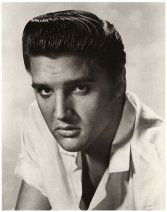
On the Road with Elvis Presley and Stan Kenton
In July 1976 I joined the Elvis Presley Road Shows with tours through much of the United States. The horn section was booked through the Las Vegas Hilton where I had subbed a few times and had contacts. Elvis’ show was not as musically demanding as the Vegas production shows but it was a thrill to play to 10,000 to 15,000 people every night and fly around the country in our own jet! His backup singers and musicians were all wonderful people and were very gracious to this young trumpeter. I was only 22 at the time. I played the July 1976 tour and four tours in 1977 which were shortly before his death.
A funny scene occurred on my first tour when I was being introduced to some of Elvis’s backup musicians from Nashville. I was not familiar with any of them since I listened primarily to jazz and classical music. So, when James Burton, Elvis’s famous lead guitarist, shook my hand and told me his name, I responded innocently with “Hi! I’m Bruce Haag. What do you play?” In spite of my ignorance, he was very nice and told me that he played the lead guitar and then chatted with me for a few minutes. I was later told by the Vegas horn players who had been standing there that it was all they could do not to burst out laughing at the “What do you play?” line. Evidently, they thought James figured EVERYONE knew what he played!
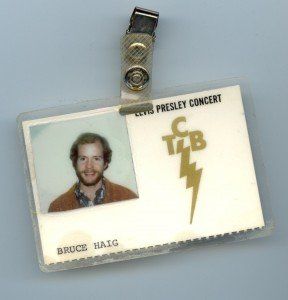
Even though I was not initially an Elvis fan, I grew to appreciate his incredible voice and unique style. I do enjoy listening to him now since my tastes have broadened over the years. Elvis enjoyed his horn section too (we were called “The Hot Hilton Horns”) and he would frequently turn around and smile at lead trumpet Walt Johnson’s stinging double high “Ds” at the end of “Hound Dog!” While playing Harrah’s in Lake Tahoe in the summer of 1977 I heard the tragic news that Elvis had died. We were all shocked and very saddened, finding it hard to believe that he was gone. The road tour that was just underway was cut short and the musicians were told to fly home back to Vegas and Los Angeles. It is unfortunate that he had not taken better care of himself and had not received the right kind of help, or he might still be with us. Even after being gone for over 40 years Elvis’s legacy continues unabated. His recordings are selling well, and his popularity is still large the world over.
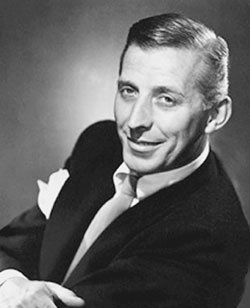
I received a call from bandleader Stan Kenton. Kenton had been on the road with his bands for nearly 40 years, bringing some of the most exciting (and at times controversial) jazz of the big band era to audiences the world over. His inclusion in Downbeat Magazine’s Hall of Fame, listed third after Louis Armstrong and Glenn Miller, reflects his influence in the world of jazz. He and his bands recorded upwards of 60 albums over the years, featuring just about every big name in jazz you can think of. He asked me if I would like to come join his band playing split-lead trumpet for the upcoming tour. I agreed of course! I had always loved the Kenton Band and the “Kenton Sound”. I had attended one of his summer jazz clinics at Sacramento State University some six years earlier. My hopes of being on his band had seemed like a faraway dream at that time, but now it was a reality. It proved to be the musical high point of my career though life on the road was physically challenging.
Musicians joined Kenton’s band mainly through referral. I had been referred by Dr. Herb Patnoe, his Summer Jazz Clinic Director and by Steve Campos, one of his current trumpets. Steve and I had been together in “Doc” Patnoe’s stellar jazz band at De Anza College in Cupertino CA years before.
Stan Kenton was still recovering from brain surgery that removed blood clots caused from a serious fall earlier in 1977. He was coming back from near total memory loss and was still weak physically. Oftentimes on-stage Stan would have difficulty with certain words or forget a musician’s name. At other times his speech would be incredibly lucid, and his piano playing would sound almost like his earlier days. Everywhere we went the audiences would show their undying love and appreciation for him with standing ovations. Kenton fans are incredibly loyal. The band was booked with almost non-stop one-nighters through most of the U. S. and Canada that year. In addition, we were in residence for five weeks of Summer Jazz Clinics at various colleges around the country. Many students from these clinics would eventually make it into the ranks of the Kenton band and beyond.
One of the most memorable concerts of the tour was at the Newport Jazz Festival in Saratoga Springs, New York on July 2nd, 1977. It was Big Band Day. All the great big bands were there, Woody Herman, Maynard Ferguson, Harry James, Ellington, etc. We followed the Ellington Band, under the direction of Mercer Ellington. Roger Homefield, our lead trombone player, described the day in comments written later: “Present were 25,000 people, plus virtually every existing big band. The band wanted to prove itself, but more we wanted to show everyone it was our common adoration for Stan that made the band great. Stan strolled slowly to the piano—it was the most emotional moment of the festival. We eased into “Body and Soul”, one of the many lush ballads, and the band and Stan and the crowd joined as one to produce a gorgeously moving concert. A magical moment and a tribute to Stan. Harry James came out next; he commenced by saying, “The band of the afternoon has just played”.
The final concert of the tour, August 20th, 1978, at Stern Grove, San Francisco, proved to be the last performance of Stan Kenton’s long career as a pianist, composer, educator and bandleader. It was an outdoor setting on a beautiful afternoon, with thousands of people sitting on the hillside amongst the trees. I thought the band had never played better. I felt the strongest I had ever been, a benefit from the 8 months of one-nighters.
Stan hoped to put the band back together after a short rest, but his strength never fully returned. He called me to see if I would like to go out again, but I was tied up in a new business. Through the following year his health declined and eventually the world of jazz lost one of its greatest contributors. Stan Kenton died on August 25th, 1979. His funeral was held privately, despite the hundreds or perhaps thousands who might have attended. Stan and his music are greatly missed.
He did not want a “ghost” band, a band of his former musicians running around saying that they were the Stan Kenton Band, which has been the practice of many other big-name bands following the death of their leader. So his vast library of jazz arrangements went to North Texas State where it is no doubt being put to good use. I am very grateful to have been part of his band and to this day I continue to draw inspiration from my association with Stan Kenton, as well as from his many fine musicians, composers, and arrangers.
After again settling down in the San Francisco Bay Area I resumed my lessons with Claude Gordon and began my own private teaching in earnest from a studio at Kurt Heisig Music in Saratoga. Claude had been splitting his time between his Los Angeles and San Francisco studios, flying his Cessna into the San Carlos Airport and teaching from “The Music Man” music store in San Mateo. The store’s owner, Larry Souza, a first-call trumpeter and skilled repairman, hosted Claude at his store for many years. Claude’s influence in the Bay Area became quite large. Most of the top players and aspiring young players came to study with him.
When “The Music Man” store closed its doors in the mid 80’s Claude needed a new place from which to teach his Bay Area students. He then came to teach for the remainder of his Bay Area teaching years at Kurt Heisig Music where I had been teaching. Our friendship grew from the many hours spent together over lunches, dinners, and just hanging out at the store. I often reflect on the good fortune I had of getting to spend so much time with Claude, being a recipient of his fine teaching and his giving spirit. This truly inspires me to carry on his teaching to the very best of my ability. To ensure that his teaching would carry on past his death, Claude instituted special year-long courses for brass teachers. These were taught in his Saratoga and Los Angeles studios. The graduates of these teacher’s courses became “Certified Claude Gordon Brass Teachers,” with adherence to the principles he so carefully taught them. I completed that course, and I can attest to the fantastic results from applying Claude’s teaching.
The Claude Gordon Brass Camps, sponsored by the Selmer Corporation, were started in 1979, and each summer attracted dozens of aspiring brass players from all over the world. Players came from Europe, Canada and all over the United States. Masashi Sugiyama, a top Japanese trumpeter, would bring a dozen or so players with him every year from Japan. The camp supplied an interpreter for them.
Every morning after breathing exercises, Claude would lecture on one of the seven natural elements of brass playing. Application classes would then follow, during which each of the staff would coach small groups of players, based on ability level, ensuring that each of the students understood and could apply the teaching from Claude’s lecture. Afternoon sessions would feature classes on literature, (classical, symphonic, and jazz,) jazz improvisation, how, what and when to practice, correct breathing from a medical standpoint, requirements of the studio musician, brass choir and brass rehearsals, construction and care of brass instruments, and much more. Evenings would feature jazz and classical recitals from staff and other prominent players such as Frank Kaderabek, Alan Kaplan, Bob O’donnell, David Evans, Larry Souza, Dave Bendigkeit, Larry Skinner, and “The Brass Band”. Trumpet star Arturo Sandoval performed at two of the camps, requesting no fee other than his travel expenses paid, as a gesture of gratitude for Claude’s contribution to the brass world and to him personally. Arturo practices from all of Claude’s books and recommends them to brass players. He plays exactly as Claude Gordon teaches. He told me so very emphatically on one occasion in response to my questions. Claude regarded Arturo as one of the greatest virtuosos of this age and he was truly delighted to have him come perform at the camps.
For several years the camps were held near La Honda in the Santa Cruz Mountains, south of San Francisco. Later they were moved to Idyllwild School of the Music and Arts near Los Angeles. Their final home was at La Sierra University in Riverside, California, where in 1992 at the second to last camp, Claude Gordon’s achievements and contributions to the world of music and teaching were recognized in the form of a formal presentation of an honorary doctorate degree in the field of “Music and Letters.”
The Brass Camps were an absolute blast! It was a full week of “eating and sleeping” trumpet, music, joking around, storytelling, (thank you Dave Evans and Carl Leach!) incredible performances, and mainly just being inspired to be the best players we could be. It was an honor to be part of Claude’s staff and to be able to help aspiring brass players on their way to success. It should be noted that without the encouragement and support of my wonderful parents I would not have been able to initially study with Claude Gordon or achieve the success that I have enjoyed as a musician. Before I was old enough to drive myself to lessons, my mother or father would drive the hour to and from Claude’s studio every week through serious Los Angeles traffic. No small feat! The lessons were not inexpensive either. I am also grateful to Talmadge “Buzz” Edie, my first band director and trumpet teacher, for his keen guidance and inspiration during those critical early years.
Thank you for reading the article! Contact Bruce today at 513-795-9234 to learn more about our brass lessons.
-
Button
BRUCE WITH JEFF BEIGHTS
Fort Wayne, Indiana
-
Button
NICK CABBINESS
Philippines
-
Button
SCOTT HEIMLICH
Cincinnati, OH
-
Button
CHRIS HEALY
Brisbane, Australia
-
Button
SAMMI AND SARA M.
Cincinnati, OH
-
Button
BOB DREYER
Florence, KY
-
Button
DALE LIERMAN
Hamilton, OH
-
Button
THOMAS KIERAN
Oak Ridge, NJ
-
Button
JARED C. AND TOMMY B.
Cincinnati, OH
-
Button
KEVIN THORNTON
Cincinnati, OH
-
Button
JOHN CHALMERS
Auburn, Indiana
-
Button
D.D. “DOC” KELSEY
Austin, TX
CONTACT INFORMATION
Phone: 513-795-9234
Email: b.haag@cinci.rr.com
Address: 618 Vincennes Ct Cincinnati, OH 45231







Venmo, Zelle
BUSINESS HOURS
- Mon - Fri
- -
- Saturday
- -
- Sunday
- Closed
By appointment only


